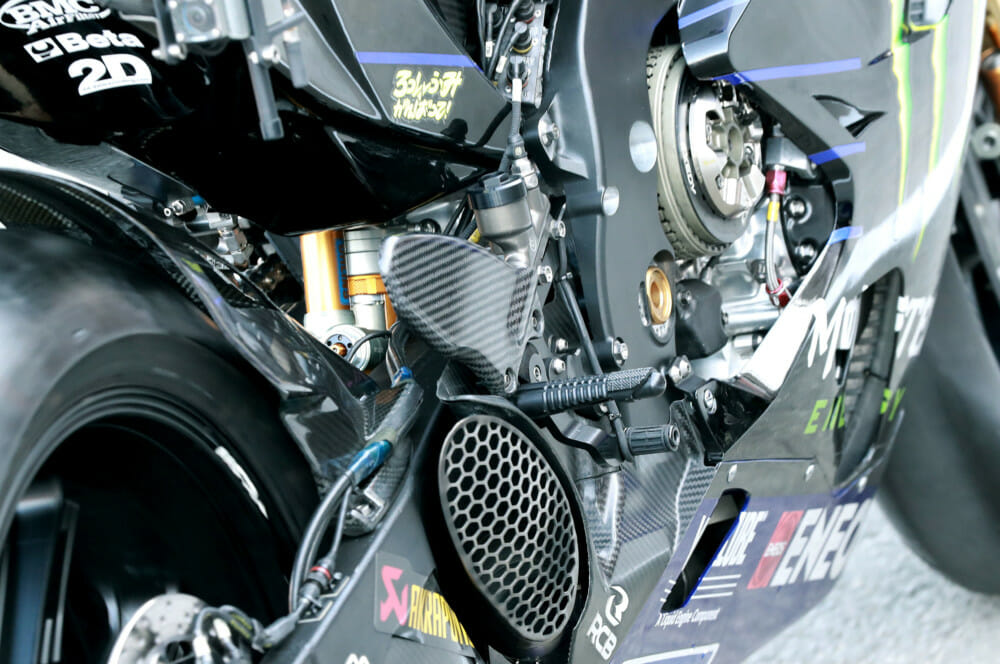Michael Scott | February 5, 2020
Cycle News In The Paddock
COLUMN
Hydrogen Bombs
Hydrogen-powered two-strokes? The more imaginative elements of the motorcycle press leapt on the idea, when it was proposed as a piece of blue-sky thinking for Formula One a week or so back.
“MotoGP to return to two-strokes” was too tempting a headline to resist.
 Will MotoGP ever return to two-strokes? There is talk.
Will MotoGP ever return to two-strokes? There is talk.
If only. Dump those big diesels and let’s get back to “real racing bikes,” no?
But there are several pungent reasons why more than just the one grain of salt is required here.
Perhaps most important is simply the vast difference between F1 and MotoGP.
F1 cars serve no purpose other than to race against one another, bearing no relationship to (say) a mass-market SUV.
F1 is a megabucks industry, independent from the automotive industry in every way, except in name, Ferrari the exception. Mercedes Benz and Renault lend their badges and spend their budgets, but the cars and the technology are from southern England’s highly specialized “F1 belt.” This is where F1 lives, and incidentally where Kenny Roberts went when he wanted to build a four-stroke to challenge the Japanese.
The technology gap between four and two wheels was demonstrated by his lack of success, as well as the all-but still-born Ilmor.
MotoGP bikes are proper motorbikes—close siblings to sportbikes and in turn even to their humbler commuter-bike brethren. The controls are the same, the electronics closely related, the engines likewise; so too the suspension systems, chassis geometry and overall design. If you can ride a sportbike, you could ride a MotoGP bike—although of course getting the most out of it requires very special talent and courage.
But the machines are kissing cousins.
In the same way, MotoGP is intrinsically intertwined with the industry, with the manufacturers’ association even writing the technical regs. When Honda, Yamaha and company go racing, they make their own engines and chassis. And there is a clear cross-over between production and racing R&D.
This is just one of the reasons why, at least to this writer and I suspect to all readers, motorcycle racing is so much more interesting, enjoyable and valuable than the up-its-own-arse world of F1.
So, back to the two-stroke question. The F1 chat, probably as much publicity stunt as sincere proposal, suggested supercharged two-stroke engines burning hydrogen. Forced induction bypasses the need to lubricate the crankshaft bearings along with the incoming combustion charge, and the consequent oil burn in the exhaust. Instead, they would emit water. And in sharp contrast to the challengingly eco-friendly but rather deadly Formula E series, they would give fans a pleasingly traditional internal-combustion exhaust noise.
But the relevance to motorcycling? Hmmm.
Much as old-timers like me, along with a comprehensive cross-section of current MotoGP riders, hanker after the purity of the two-stroke racing of the past.
The industry that supports motorcycle racing is not covered with glory, for it was the big players—notably Honda and Yamaha—that conspired to drop 500cc two-strokes in favor of big four-strokes. This was entirely for marketing reasons.
Street two-strokes—light, agile and exciting in the same way as their racing counterparts—had fallen out of favor with misguided green campaigners (the forerunners of those Australians who stopped traditional bush clearance and fire-breaks, and thus provided fuel for runaway bush fires).
It was that visible exhaust smoke that killed them.
Obliged to sell big four-strokes, the industry decided they ought to race them as well.
A tragedy, really. Two-stroke engines are at least 100 times better suited to motorcycles, for all sorts of reasons. They are lighter, more compact, much simpler to manufacture and maintain, and their throttle response is like a light switch. Their valveless operation works acoustically, like a musical instrument, and as a result they respond to personal engineering genius rather than roomful of computer boffins. Hence a lost generation of one-man race-team tuning geniuses, the Stradivariuses of their time.
Most importantly, making a two-stroke requires much fewer components and hardly any of the polluting special metals and intensive hardening processes essential to a top-heavy twin-cam multi-valve four-stroke. A significant proportion of any vehicle’s overall pollution comes during manufacture, and the more complex the engine the more that is true.
At the time of the switch to MotoGP four-strokes in 2002, improved metallurgy, lubrication and electronics including fuel injection were already well advanced in addressing the two-stroke exhaust-smoke problem. Supercharging was also on the menu, which entirely eliminates it.
Continuing to race two-strokes would have accelerated development; modern sportbikes would have been lighter, more responsive and faster than the overly complex current offerings. And cheaper into the bargain.
The problem with two-strokes, as Harald Bartol, one of those famous two-stroke tuners, explained to me, is that “they smell of poor people.”
Headlines that suggest an imminent return to two-strokes for MotoGP, meanwhile, smell of fish.CN
Click here for all the latest MotoGP news.